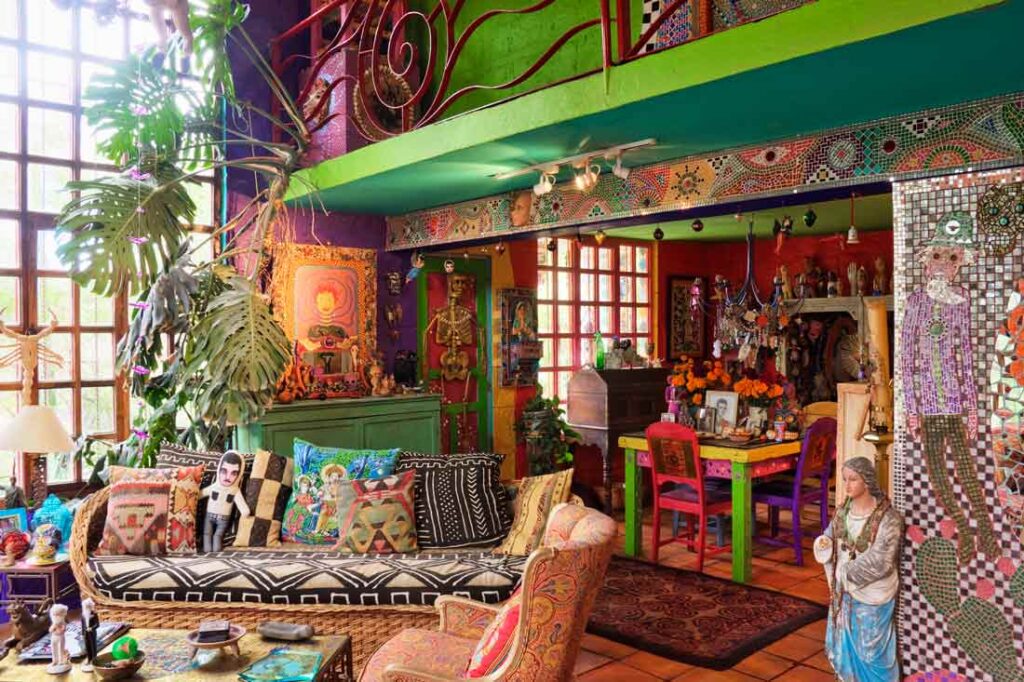Remember the days when we were supposed to Marie Kondo everything in our home by asking, “Does this spark joy?” Well, times have changed.
“More is more” and “the bolder the better” are now en vogue as more people turn to maximalist interior design for comfort. Instead of focusing on tossing what doesn’t bring us joy, it’s all about bringing more elements of passion and positivity into our living space.
While the principles of maximalism can be traced back centuries, it appears to be making a comeback. People feel uneasy about the economy, politics, climate change, war and all-around perceived impending doom. As it turns out, maximalism can be the antidote to this unsettling time in history.
“I believe maximalism is rooted in the idea of surrounding yourself with the things you love,” explains Rudy Saunders, design director at Dorothy Draper & Company. “To be around mementos from trips, furniture or accessories that are family heirlooms or really any piece that brings you joy or tells a story is a comforting feeling.”
What is maximalism in interior design?
Maximalist spaces are artfully decorated using bold colors, bright wallpaper, ornate accents like chandeliers, layered fabrics and statement pieces. Think mixed patterns with contrasting motifs like animal print, geometric shapes or florals. Unlike minimalism, the decor doesn’t have to be refined, seamless and fully coordinated. Layering in favorite objects, vivid colors and striking patterns is encouraged—as long as it spurs energy, excitement and pleasure.

Just don’t confuse this style with clutter. As Isfira Jensen, CEO and principal designer of Nufacet Interiors, points out, there are some rules to keep in mind. “You can make elements work together as long as they have a connection to the existing space,” she says. “If you have a steel coffee table, for example, you can add a few metal pieces to make it intentional and not random.”
Why is modern maximalist interior design trending?
Why the revival of maximalism in design now? A backlash to minimalism, fear related to economic uncertainty and a reaction to the COVID-19 pandemic (and subsequent lockdown) are the key reasons, design pros speculate.
According to Jennifer Howard, author of Clutter: An Untidy History, a counteraction to minimalism has been going on for years. “I think it’s a cyclical thing. Nobody wants Grandma’s china and midcentury furniture. Wait, everybody wants Grandma’s china and midcentury furniture!”
Maximalism offers more opportunities for creative self-expression than minimalism does. Plus, it plays better on social media and gets people’s attention. Additionally, Jensen thinks we are seeing more maximalist design because people are tired of bland interiors and want to reinvigorate and relish where they live.
Economic uncertainty due to inflation, the rise of AI and layoffs and strikes in several sectors may also be the impetus for craving bolder decor. While it seems counterintuitive, Jensen believes maximalism is actually appealing in financially challenging times because it allows people to incorporate thrifted items and upcycled furniture. Furthermore, minimalistic design can be more expensive because fewer elements means each one must have a “wow” factor, often with a higher associated cost.
Maximalist design gives us back agency in unprecedented times
Dr. Alice Condé agrees that maximalist interior design is gaining traction in this cost-of-living crisis. She is a lecturer in the department of English and creative writing at Goldsmiths, University London and co-deputy director of the Decadence Research Centre at the university.
“It’s becoming more difficult to afford even the basic necessities, and I think this can cause people to invest what they can in themselves, be this through fashion, culinary adventures or the style of their living environment,” she explains. She finds herself choosing smaller, more affordable items that suit her aesthetic taste and give more of a sense of ownership over the rented space she inhabits. “I can see that maximalism—on whatever budget—could be one way of responding to a similar feeling of disenfranchisement. There’s something appealing about the idea of ‘more than necessary,’ especially when even basic necessities are becoming more and more expensive.”
Finally, we can’t discount the role COVID-19 has played in boosting maximalist design. “Being forced into our homes during the pandemic may have prompted a change here, causing people to invest in things, objects, decorations, etc., to help them feel more of a sense of enjoyment or control over their space,” Condé suggests. Without being able to go out and experience vibrant places like art galleries, concert venues and nightclubs for so long, people turned to bold and bright furnishings and decor to fill this need.
“It may also be seen as a response to fear of decline and the almost apocalyptic environment we found ourselves in,” Condé adds. “We might as well enjoy ourselves while we can!”
Maximalism is all about finding comfort in the stuff we love
Some people find comfort in material items, and that’s OK. While Howard does not see value in clutter for herself, she understands this phenomenon.
“It’s human to attach meaning to objects we associate with significant people, places or events in our lives,” she says. “Looked at that way, things can serve as memory keepers and tangible links to our identities and personal histories. It’s also human to seek out spaces that feel safe, comfortable and welcoming.”
It is especially common for people who grew up in eras with scarcity from war and economic uncertainty, for example, to gravitate to possessions to feel more at ease.
Ramit Sethi, author and host of Netflix’s How to Get Rich, encourages people to discover their idea of happiness and success wealth-wise, recognizing it can be completely different for everyone. On his YouTube channel, he tells listeners to use their money to live their own rich life and to spend it consciously. “Spend extravagantly on the things you love and cut costs mercilessly on the things you don’t,” he advises. He admits that money can buy happiness, such as by building memories and buying things we love and treasure.
Jensen believes the psychological impact of maximalism is even more significant than the financial benefit. “Being surrounded by objects and plenty of colors you love can have an incredible effect on your happiness and well-being.” This design approach offers a way to fill even small spaces with cherished items and vibrant hues, helping to achieve a sense of luxury and fulfillment.
How to do maximalism right
If not done correctly, maximalist interior design can look like clutter and chaos, and it can trigger stress and overwhelm instead of the calm and inviting feelings people are seeking. Dr. Beverly Walpole, a registered psychologist focused on holistic wellness and designing healthy spaces for the whole family, warns about the downside of having too much stuff. “People need to be very intentional and thoughtful about what is in their space because busying up a home with too much can be problematic. Clutter in our space can quickly become clutter in our minds.”
Going big with plants, books and art is a safe and effective way to carry out maximalism. Walpole suggests devising a gallery wall to display big, beautiful family portraits and photography or art to capture personal history, vacations and special moments. As a self-proclaimed biophiliac (having an instinctive love for the natural world), she encourages people to bring lots of nature and plants into their home.
“Maximize plant space. They feel great all the time. Having a plant wall or an enormous plant can feel incredible, and you can’t overdo it with greenery,” she says.
Finally, book lovers should not be shy about showcasing their collection. A grand floor-to-ceiling bookcase can make everyone who visits the space want to curl up and get lost in a good story.
Discover if maximalist interior design is for you
Fortunately, there is an abundance of design styles for every personality type. Decorating an entire home with maximalist decor may not work for everyone, so it’s imperative to recognize what works for you.
Jensen points out that “it’s the more audacious and loud people who enjoy this type of setting and don’t get overwhelmed by it.” People who are more exuberant and boisterous love color and pattern and tend to be attracted to maximalism. More reserved, introverted people who seek out serene spaces may choose to stick to minimalist and spa-like environments.
Before jumping into maximalist design, Jensen recommends reviewing images to see how they make you feel. Also, spend time pondering the following questions:
- Do you prefer bold and vibrant colors in your home decor over neutral or muted tones?
- Do you tend to mix and match different bold patterns and textures in your space?
- Do you find comfort in rooms filled with striking objects and artwork, or do you feel that it overwhelms you?
- Do you believe that more is more when it comes to decorating your space?
- Do you enjoy personalizing your space with items that have sentimental value or tell a story?
Finding out what makes you and your family comfortable and joyful is the main priority. As we buckle up for what’s expected to be another tumultuous year, consider experimenting with maximalist interior design to boost your mood and ensure your home is your happy place.
Photo by New Africa/Shutterstock.com



